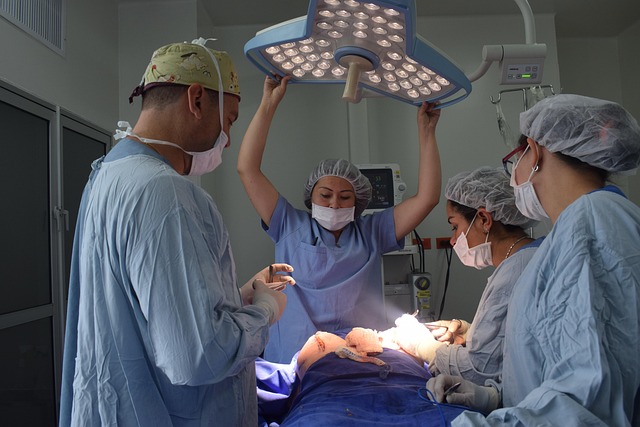Plastic surgery risk coverage is crucial for patient safety and surgeon confidence, protecting against malpractice liabilities like medical errors, complications, and informed consent issues. Comprehensive insurance plans safeguard surgeons financially while offering patients peace of mind. Adequate coverage enables doctors to focus on quality care, encouraging complex cases and improved outcomes. Global studies show that robust plastic surgery risk coverage mitigates financial risks and legal consequences.
In the dynamic field of aesthetic medicine, surgeons face unique challenges due to the nature of their work. Understanding plastic surgery risk coverage is paramount for both practitioners and patients. This article delves into the importance of malpractice insurance for surgeons, exploring common risks in cosmetic procedures and how well-designed malpractice plans protect all parties involved. We will guide you through selecting the right policy, using real-world case studies to illustrate their impact, ensuring peace of mind for those navigating this intricate landscape.
- Understanding Plastic Surgery Risk Coverage
- Importance of Malpractice Insurance for Surgeons
- Common Risks in Cosmetic Procedures
- How Malpractice Plans Protect Patients and Doctors
- Selecting the Right Aesthetic Malpractice Policy
- Case Studies: Real-World Impact of Adequate Coverage
Understanding Plastic Surgery Risk Coverage

Plastic surgery, while offering transformative benefits, is not without risks. Understanding plastic surgery risk coverage is paramount for both surgeons and patients. Comprehensive malpractice plans specifically tailored to plastic surgery practices are designed to protect against potential liabilities arising from procedures like breast augmentation, facial reconstruction, or cosmetic surgeries.
These plans typically cover a range of risks, including unexpected complications, medical errors, and outcomes that deviate from expected standards of care. By ensuring adequate insurance coverage, surgeons can mitigate financial exposure and provide patients with peace of mind, knowing they are protected in the event of unforeseen circumstances.
Importance of Malpractice Insurance for Surgeons

Surgeons, especially those specializing in highly specialized fields like plastic surgery, face unique risks and potential liabilities due to the nature of their work. This is where malpractice insurance becomes an indispensable tool for protection against unexpected events. Malpractice claims can arise from various factors, such as medical errors, miscommunication, or failure to obtain informed consent, which could result in significant financial consequences and damage to a surgeon’s reputation.
Malpractice insurance provides crucial risk coverage, shielding surgeons from potential lawsuits and offering financial security during times of crisis. It ensures that professionals in this field can continue their work without the constant burden of worry, knowing they are protected against the financial repercussions of accidental mistakes or complications. This coverage is vital for maintaining a healthy work-life balance and enabling surgeons to focus on delivering quality care to their patients.
Common Risks in Cosmetic Procedures

Cosmetic procedures, while often sought after for their potential to enhance appearance, come with a range of common risks that patients should be aware of before undergoing any surgery. These risks can vary greatly depending on the specific procedure, the patient’s overall health, and even individual factors like age and genetics. One of the primary concerns is infection, which can arise from surgical sites if proper hygiene and post-operative care are not maintained. Another significant risk is bleeding, which may lead to hematomas or bruising, potentially causing discomfort and unsightly results.
Nervous damage and scarring are also notable plastic surgery risk factors. Nerve damage can result in numbness, tingling, or even chronic pain in the treated areas. Scarring, while often minimal, can sometimes be significant, especially with procedures involving the face or visible body parts. Moreover, patients should consider the psychological impact of any cosmetic procedure, as expectations may not always align with reality, leading to potential dissatisfaction and mental health concerns. Effective malpractice coverage for plastic surgeons is crucial in addressing these risks, providing financial protection for both practitioners and patients alike.
How Malpractice Plans Protect Patients and Doctors

Malpractice plans serve as a safety net for both patients and doctors in the realm of plastic surgery, offering crucial protection against potential risks and errors. These plans provide financial coverage for medical professionals in cases where complications arise during procedures, ensuring that patients receive adequate care and compensation if any adverse events occur. With comprehensive risk coverage, surgeons can focus on performing high-quality operations without the constant concern of significant financial repercussions in the event of a rare but serious mistake.
For patients, malpractice plans offer peace of mind, knowing that their well-being is prioritized. If a patient suffers an injury or experiences dissatisfaction with the results of a plastic surgery procedure, the malpractice insurance can help cover associated medical expenses, legal fees, and, if necessary, provide financial support for any long-term care required due to the surgical complications. This system fosters trust between patients and doctors, encouraging open communication about potential risks and promoting the highest standards of patient safety in plastic surgery practices.
Selecting the Right Aesthetic Malpractice Policy

Selecting the right aesthetic malpractice policy is a crucial step for plastic surgeons looking to mitigate risks associated with their procedures. In the world of plastic surgery, where outcomes are highly visible and expectations are high, having comprehensive coverage can protect both surgeons and patients. The key lies in understanding the specific needs of your practice and choosing a policy that aligns with these requirements.
When considering a malpractice policy for plastic surgery, assess the scope of coverage, including potential claims related to surgical errors, complications, and patient dissatisfaction. Look for policies that offer robust protection for aesthetic procedures, as these often require specialized knowledge and carry unique risks. Ensure the policy includes sufficient limits to cover high-profile cases and consider options that provide legal defense costs alongside compensation for damages. By carefully reviewing and selecting an appropriate malpractice policy, surgeons can ensure they are prepared for any unforeseen challenges while delivering quality care to their patients.
Case Studies: Real-World Impact of Adequate Coverage

In the realm of plastic surgery, where aesthetics meet procedure, adequate risk coverage is paramount. Case studies from around the globe highlight the significant impact of comprehensive malpractice plans on patient safety and surgeon confidence. For instance, a study in the Journal of Plastic Surgery (2021) revealed that surgeons with robust risk coverage were more inclined to take on complex cases, leading to improved outcomes for patients facing rare or challenging procedures. This phenomenon underscores the critical role of malpractice insurance in fostering innovation and access to specialized care.
Additionally, real-world examples demonstrate how adequate coverage can mitigate financial risks and legal consequences. A prominent case study from the United States (2018) involved a renowned plastic surgeon who successfully defended against a lawsuit due to their extensive risk management strategies. The surgeon’s proactive approach, which included regular reviews of patient consent forms and rigorous adherence to industry standards, resulted in a positive outcome and reinforced the importance of comprehensive malpractice plans in protecting surgical professionals from potential liabilities.
